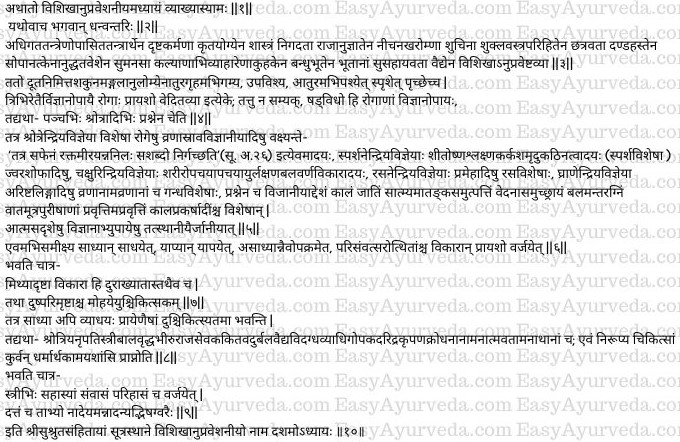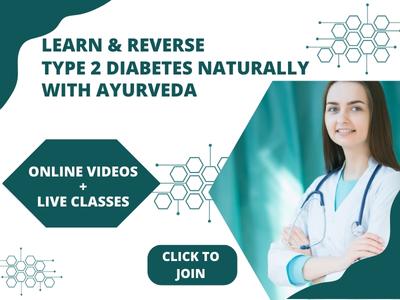This article explains Sushruta Samhita Sutrasthana Chapter 10 “Vishikhanupraveshaniya Adhyaya”- Entering into the Profession.
Vishikhanupraveshaniya Adhyaya
We will now expound the chapter by name Vishikhanupraveshaniya – entering into the profession; as revealed by the venerable Dhanvantari.
Vrtti Pravesa Adhikara
Eligibility to enter the profession
The physician who has completed the study of the texts – as taught by his teacher, understood the meaning / interpretations (of the precepts), observed the actions (application of therapies, surgical methods etc. as done and demonstrated by his teacher and their effects), made fit (through practical training), capable of recapitulating the teachings of science always, having obtained permission and certificate from the king (government) – to practice the science and surgical methods, having removed unkempt / ugly nails and hairs, (of the head, beard and moustaches) and keeping clean – by taking bath, wearing clean white dress, holding an umbrella and staff, putting on a footwear, being dressed in a simple way (not being gorgeously attired), maintaining a calm (good, balanced, , pleasant) mind, uttering well-wishing words for everyone (wishing the good of all living beings), being (having an attitude of becoming) a good companion and compassionate friend to all, accompanied by good assistants, should enter into the profession (of medicine).
Notes:-“Visikha” means removal of the tuft of hair on the head. This is done and shall be maintained during the period of studentship as a part of customary practice. This would be shaved off after the completion of education (studentship).
Obtaining the permission from the king – The mention of this shows that stringent rules and regulations so as to control and regulate the medical practitioners existed even during ancient times. Nowadays we have ‘Registration of medical practitioners.
Insistence of ‘wearing of white dress’ is symbolic of cleanliness; we have aprons in the modern-day medical practices.
Use of umbrella and staff (walking stick) signify dignity and high status the physicians used to enjoy in the society, a privilege which only officials of higher cadre (including physicians) often enjoyed. Many times, an attendant used to carry the physician’s umbrella (to hold it protecting the physician from heat, wind and rain).
Insistence to wear simple dressing by the physician is to emphasize that the physician should appear as simple as possible. This will make him or her easily reachable even to the poor people (patients). Poor and lower-class people may not get the courage of approaching a doctor who looks rich, wearing wealthy and gorgeous costumes.
It is indicated that the physician should not behave like a quack. This is a gentle warning to the physician to always be careful in his conduct and behaviour without which he may lose respect and reputation.
Being friendly with all living beings, showing compassion towards the suffering and wishing happiness to all – is the philosophy of the medical profession. Every physician should inculcate these things in his or her life.
Read – Ethics Of A Physician – Vaidya Vritti
Rogi Pariksha
Examination of the patient
Afterwards, taking note of the duta – auspiciousness of the messenger (who has come to take the physician to the patient’s house), nimitta – omens, shakuna – portents (happenings on the way – to the patient’s house) and mangala – activities signifying good / goodness, the physician should enter the house of the patient, get seated and then observe, touch and enquire. Some authorities opine that by these three methods (inspection, palpation and interrogation) all diseases become recognized (diagnosed). But that is not correct. There are six methods of understanding (diagnosing) the diseases, such as – examination by the five sense organs (ear etc) and by interrogation (questioning).
Read – 10 Factors Of Patient Examination – Dasha Vidha Atura Pareeksha
Details about Pancendriya Pariksha
Examination, understanding and diagnosing diseases with the help of sense organs
Information obtained by Sravanendriya (organ of hearing) – The different kinds of information about the diseases obtainable through the organs of hearing (ears) will be described later in the chapter named Vrana Srava Vijnana (Ch. 26) such as – ‘frothy blood coming out accompanied with sound, forced by Anila (Vata) etc.
Information obtained by Sparsanendriya (organ of touch – skin) – The information available through the organ of touch (skin) are – cold, heat, smoothness, roughness, softness, hardness etc, in fever, oedema and other diseases.
Information obtained by Caksurindriya (organ of sight – eye) – The information available through the organ of sight (eye) are increase and decrease (of the size of the body), signs of life-span, changes of strength and colour of the body etc.
Information obtained by Rasanendriya (organ of taste – tongue) – The information available through the organ of taste (tongue) are – the different tastes in diabetes and such other diseases.
Information obtained by Ghranendriya (organ of smell – nose) – The information available through the organ of smell (nose) are – the different odours appearing along with fatal signs, in ulcers and non ulcerous diseases.
Information obtained through Prasna i.e., questioning – The information available through questioning are nature of the habitat, time (season), caste, accustoms, causes of onset of diseases, exacerbation of the symptoms, strength, nature of internal (digestive) fire, elimination or non- elimination of flatus, urine and faeces, time of exacerbation of the disease (symptoms) etc. Other similar information may be obtained through locals (relatives, friends’ etc persons near to the patient).
The diseases which have not been examined through the five organs of sense or the diseases whose proper information has not been properly given by the patient or attendants, or those which have not been properly enquired (interrogated) will put the physician in a state of confusion during the treatment (planning and implementation).
Read – Indriya Pancha Panchaka: 5 Fives Of Sense Organs
Notes:- Dalhana,the commentator interprets the term ”Sthaniya (local) as ‘symptoms not mentioned here but found in the seat of the diseases. This interpretation does not seem to be appropriate since the context is of interrogation. Haranacandra, a recent commentator interprets the term to mean, Sthaniya jana (local people) to include persons residing with or living near the patient. This explanation is more appropriate.
In this way, after properly examining the patient and the disease (gathering thorough information about the diseases after examination of the patient), the sadhya rogas – diseases which are curable should be cured.
The yapya rogas – those that tend to persist (manageable but cannot be cured in entirety) should be controlled by proper and timely administration of the medicines and treatments i.e., take caution that the patients are not troubled by those diseases.
The asadya rogas – diseases which are incurable should not be treated.
The parisamvatsarothita rogas – long-standing diseases – The diseases which have persisted for more than one year shall not be treated (refused treatment) because they are also generally incurable.
Read – Classification of Vyadhi (diseases) according to Ayurveda
Sanskrit Verses

Diseases which would confuse the physician while treating
Diseases which are observed improperly (by the physician), which have not been described well (by the patient or his kin) and which have not been examined thoroughly (and diagnosed correctly) are going to confuse the physician.
Persons and conditions in which the curable diseases become incurable.
Even the (easily) curable diseases become difficult to cure in the below mentioned persons / conditions –
- vedapati – those who read and recite Vedas daily, orthodox persons (who adheres rigidly to the rites and rituals prescribed in the scriptures),
- the king
- women
- children
- the aged
- the frightful
- servants of the king (officials)
- the gambler
- the debilitated
- those who pretend as physicians
- those who conceal their diseases
- the poor
- the miser
- the angry man (those who always get angry)
- those who do not care about self and are indisciplined with respect to their food habits and life activities (those who are not disciplined in their senses and mind) and the destitute
He (the physician) who commences the treatment of diseases after intimating this (difficult cure) to the patients will obtain righteousness, wealth, desire and success.
The ideal physician should avoid sitting together with women, residing with them, having fun with them, accepting anything given by them except food.
Thus ends the Tenth chapter by name Visikhanupravesa, in Sutra Sthana of Susruta samhita.



